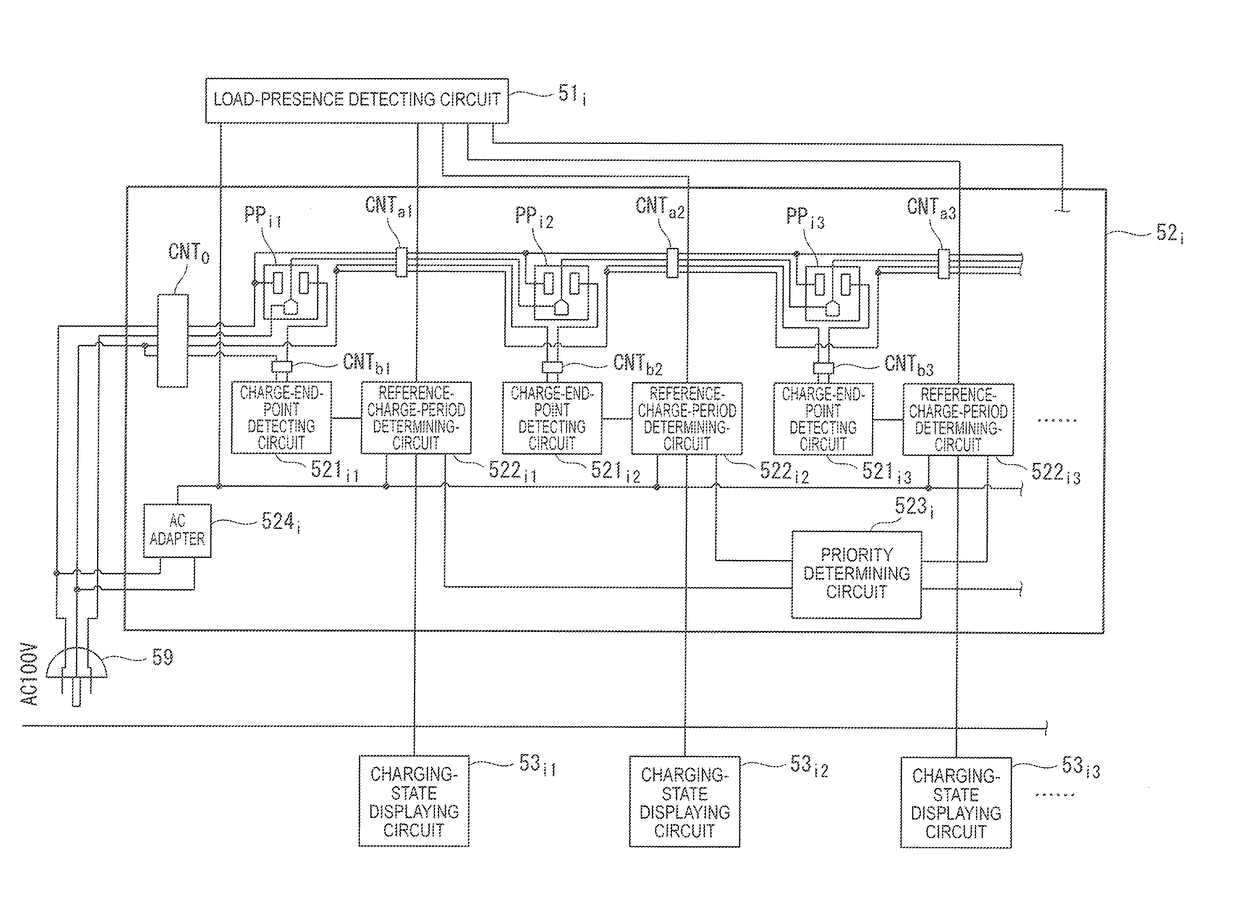Charging system
a charging system and charging state technology, applied in the direction of indicating/monitoring circuits, instruments, transportation and packaging, etc., can solve the problems of significant need for routine checking of the charged state of nickel metal hydride batteries, affecting the use frequency of devices, and reducing battery capacity, so as to prevent the imbalance of use frequency, accurately monitor the charging status, and eliminate the effect of erroneous operation
- Summary
- Abstract
- Description
- Claims
- Application Information
AI Technical Summary
Benefits of technology
Problems solved by technology
Method used
Image
Examples
first embodiment
[0049]As illustrated in a side view of FIG. 1, in a charging system according to the first embodiment of the present invention, a plurality of charge scheduled devices IUC1a, IUC2a, . . . , IUC5a; IUC1b, IUC2b, . . . , IUC5b are arranged over side walls of a tower (21, 22, 23a, 23b, 23c, 23d, and 29), which extends in an elongated shape with a constant width. The tower (21, 22, 23a, 23b, 23c, 23d, and 29), a top view of which is illustrated in FIG. 3, includes a box-shaped display panel 21 extending in the height direction and a box-shaped pillar portion 29, which is connected to a center portion of one of the side faces of the display panel 21, such that a cross-sectional shape of the tower (21, 22, 23a, 23b, 23c, 23d, and 29) cut along a horizontal plane creates “T” shape. As illustrated in FIG. 3, because the top surface of the box-shaped display panel 21 extending in the height direction is recognized as a rectangular shape, the outer shape of the display panel 21 can be underst...
second embodiment
[0092]As illustrated by a front view in FIG. 17, a charging system according to a second embodiment of the present invention is built up from racks (71a, 71b, 72, 73, 211, 212, 213, and 214) instead of the tower (21, 22, 23a, 23b, 23c, 23d, and 29) described in the first embodiment. In other words, the racks (71a, 71b, 72, 73, 211, 212, 213, and 214) implementing a frame of the charging system according to the second embodiment includes a plurality of shelves 21i (=211, 212, 213, and 214), horizontal boards 71a and 71b that support the plurality of shelves 211, 212, 213, and 214, and a top board 73 that connects the upper end portions of the horizontal boards 71a and 71b. In addition, a power-breaker installation-case 72 that is a box of a vertically-long rectangular parallelepiped is arranged in the vertical direction along a rear end portion of the left horizontal board 71a. In FIG. 17, the power-breaker installation-case 72 located at the rear side is intermittently exposed at a ...
third embodiment
[0110]In the charging systems according to the first and second embodiments, when both the “load-presence detecting signal” and the “current-detecting signal” are fed, the predetermined period—for example, 15 hours—is counted, and, when a state in which the “current-detecting signal” is not fed is continued for a predetermined time—for example, ten minutes—, the counting of the predetermined period is skipped, and a “charging-completion signal” is transmitted to the priority-determining circuit. Then, based on the order in which the respective “charging-completion signals” are entered, the priority in the use order of a plurality of charge-scheduled devices are determined. However, in a charging system according to a third embodiment of the present invention, the charging-state of each charge-scheduled device can be individually determined, and the priority in the use order of charge-scheduled devices can be determined without counting the predetermined period and without causing a ...
PUM
 Login to View More
Login to View More Abstract
Description
Claims
Application Information
 Login to View More
Login to View More - R&D
- Intellectual Property
- Life Sciences
- Materials
- Tech Scout
- Unparalleled Data Quality
- Higher Quality Content
- 60% Fewer Hallucinations
Browse by: Latest US Patents, China's latest patents, Technical Efficacy Thesaurus, Application Domain, Technology Topic, Popular Technical Reports.
© 2025 PatSnap. All rights reserved.Legal|Privacy policy|Modern Slavery Act Transparency Statement|Sitemap|About US| Contact US: help@patsnap.com



